Author: @Moose777_ @Nihaovand
Preface
This article will analyze the RWA track and the track segment player Ondo Finance from the following three aspects in order:
1. Starting from the macro status of web3, by extracting the latest market data and combining the data of the two major global securities markets, A-shares and US stocks, we can observe the current problems and status of the web3 track;
2. Starting from the RWA track, analyze the impact of the RWA track on the industry ecology;
3. Using Ondo Finance as a use case, analyze the product’s revenue solution;
1. Analysis of the Current Status of Web3
1. Current status of Web3 development
According to market data, the average market value of the cryptocurrency market in 2024 is about 2.6 trillion US dollars, an increase of 62.5% from the previous bull market (the average market value in 2021 was 1.6 trillion US dollars);
Many leading financial and fund companies have included cryptocurrency assets in their asset allocation, and many sovereign countries have accepted cryptocurrency assets as strategic reserves; representative cases include: MicroStrategy, Grayscale, Tesla…
But at the same time, cryptocurrencies also face many challenges, such as insufficient liquidity, unclear value assessment, security and centralized review.
2. Data Analysis and Comparison
1. Concentration & Market Value
According to the data on the afternoon of February 23, 2025, the market value of the cryptocurrency market is 3319.774 billion US dollars. During the same period, according to the closing data on February 20, 2025, the total market value of China's A-share market is about 13784.617 billion US dollars, and the total market value of the US stock market is about 82102.492 billion US dollars. The detailed data is shown in the following table:

Data source: Coingecko, Wind
Data shows that regardless of whether the impact of the two largest cryptocurrencies in the current cryptocurrency market, BTC and ETH, is excluded, the concentration of the cryptocurrency market is much higher than that of the A-share and US stock markets.
This means that the Crypto market is in a highly monopolistic ecosystem, with BTC+ETH accounting for 70% of the market value, forming a duopoly.
This reflects the market's lack of confidence in other cryptocurrencies. To put it bluntly, it means that the market has lost its "value recognition" for Altcoin, and funds are concentrated in mainstream coins. The result is that the liquidity of long-tail projects is seriously insufficient, which has been reflected in the price trend of TGE projects.
2. Trading volume & market value
According to the data on the afternoon of February 23, 2025, the transaction volume of the cryptocurrency market was US$84.74 billion. During the same period, according to the closing data on February 20, 2025, the total transaction volume of the Chinese A-share market was approximately US$255.923 billion, and the total transaction volume of the US stock market was approximately US$536.172 billion. The detailed data is shown in the following table:

Unit: 100 million US dollars
Data source: Coingecko, Wind
Data shows that the ratio of cryptocurrency market transaction volume to market capitalization (2.55%) is better than that of A-shares (1.86%) and US stocks (0.65%), but market liquidity is still insufficient. The reason is that apart from cryptocurrencies with good liquidity, the liquidity of the remaining cryptocurrencies is seriously lacking; in short, most traders gather in the top mainstream currencies for trading, and the number of traders of Altcoin is relatively small.

Unit: 100 million US dollars
Data source: Coingecko, Wind
The top 40 cryptocurrencies in terms of trading volume contribute 99.67% of the trading volume, while the remaining cryptocurrencies contribute 0.33% of the trading volume, and their market trading volume to market value ratio (a/b) is only 0.09%. However, the market value of the remaining cryptocurrencies is about 90% of the market value of ETH. Judging from the market value alone, this is a very large currency collection.
Here is another data reference: the average daily real estate transaction amount in Beijing in 2023 accounts for about 0.042% of the amount of real estate for sale (new + second-hand) in Beijing in 2023. According to the above comparison, the liquidity of non-head cryptocurrencies is indeed worrying, which is also very consistent with the information of the concentration data.
3. Trading price volatility
As can be seen from the table below, the volatility of cryptocurrencies is indeed higher than that of traditional currencies or general equivalents such as gold, but due to the strengthening of consensus and the development of the industry, the digital gold attributes and currency attributes of Bitcoin and Ethereum are becoming more prominent, and the value fluctuations are becoming more stable. Other currencies (such as SOL) fluctuate quite violently, and are more like a crypto-security than a cryptocurrency.
I believe that if we extract other cryptocurrencies with poor liquidity and low market capitalization discussed above, the volatility reflected in their data will be more severe. The drastic price fluctuations increase the risk of liquidity provision, which will reduce the willingness of market makers and liquidity providers to provide liquidity in the case of mismatched returns, thus forming a negative cycle. Even if many cryptocurrencies can be listed on exchange platforms, many of them are at their peak when they are listed, and investment institutions and retail investors withdraw from the market until liquidity is exhausted.

Data sources: Coingecko, Wind. The US dollar index is anchored by the 1973 US dollar as 100.
Statistical range: January 1, 2021 - February 23, 2025, excluding dates with no Comex gold trading data. The trading range of products other than cryptocurrencies is natural days, and the closing price of cryptocurrency transactions is calculated based on 0:00 Beijing time zone.
Indicator calculation: The calculation formula for the absolute value of volatility is abs (today's closing price/previous day's closing price-1) and the average value is taken within the statistical range; the calculation formula for the maximum volatility is (maximum value/minimum value-1) within the statistical period.
(III) Analysis of existing problems
1. Liquidity dilemma
I personally think that the liquidity dilemma exists in two aspects:
One is that consensus is concentrated on the top cryptocurrencies, and due to the investment strategies of currency holders and consensus mechanisms such as POS, the liquidity caused by the long-term holding or pledge/loss of currencies such as BTC and ETH on the corresponding chains has not been released.
Regarding solutions in this regard, there are already a lot of applications and projects in the Defi field. Whether it is Solv issuing pledge tokens for secondary staking through re-staking, LSD and LST mechanisms, or Babylon releasing liquidity through remote staking of Btc, they all provide many solutions for the release of liquidity of leading currencies.
On the other hand, according to the data analysis in the previous article, the liquidity dilemma is reflected in the lack of liquidity of non-head cryptocurrencies (Altcoin).
I think the main reasons for this are:
(1) Actual application scenarios and users’ judgment of project fundamentals are the driving force of liquidity. If the actual application scenarios are vague and lack fundamental support, then weak currency consensus will naturally lead to a lack of liquidity;
(2) The liquidity of the blockchain market is often driven by “hot narratives”, which are usually short-term. Once the narrative loses its appeal, market funds quickly withdraw/transfer, causing liquidity to dry up and tokens to lose traders. In this process, liquidity providers and project owners find it difficult to grasp the timing and bear high risks while providing liquidity for the currency.
2. Ambiguous Value
The value of cryptocurrency comes from consensus, and the embodiment of consensus is the collection of mainstream and non-mainstream values and things recognized by different groups; just like BTC has created a decentralized currency system, which is recognized by everyone as the trend of the next stage of society, that is, the future
Many cryptocurrency enthusiasts agree that the future society is decentralized
Every cryptocurrency must find its own value, whether it is culture & sentiment (meme), defi (bringing more benefits to cryptocurrency holders and stakers), or reducing the original transaction costs through expansion, but the premise for achieving consensus is clear value.
It is undeniable that those advanced terms and application scenarios are very fascinating, but the cryptocurrency market is still in a stage of rapid growth and taking on external members. Business logic that can be recognized by many new investors with less knowledge reserves will help web3 gain more attention and builders.
3. How to spread faith
Events such as the Russian-Ukrainian war have exposed the unreliability of the centralized financial system, and the decentralized nature of the cryptocurrency system provides a possible solution to this problem. How to accelerate the process of acceptance, gain the trust of the majority, and spread faith are important topics.
The tokenization of real-world assets can serve as a case worth studying in this context, as it can better enable external investors to recognize the value of Web3.
2. RWA Track Analysis
1. Definition
To bring real-world assets into DeFi, the value of the assets must be “tokenized” — the process of converting something with monetary value into a digital token so that its value can be represented and traded on a blockchain.
Tokenized real-world assets (RWAs) are digital tokens recorded on the blockchain that represent ownership or legal rights to physical or intangible assets. Any real-world asset with a clear monetary value can be represented by an RWA. RWAs can represent tangible assets, including real estate (residential, commercial properties, and real estate investment trusts REITs), commodities (gold, silver, oil, and agricultural products); they can also represent intangible assets such as art and collectibles (high-value art, rare stamps, and vintage wines), intellectual property (patents, trademarks, and copyrights), carbon emission indicators, and financial instruments (bonds, mortgages, and insurance policies).
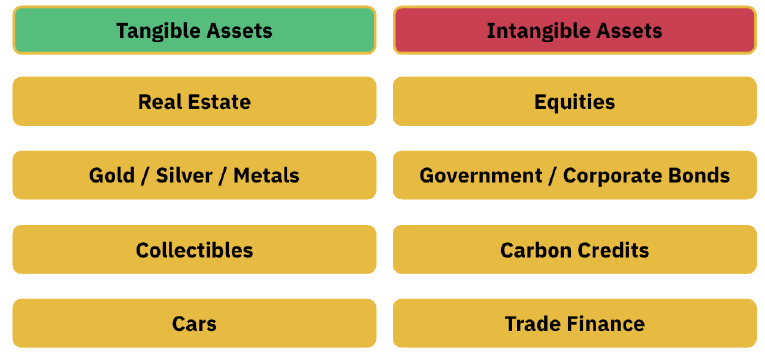
Source: Binance Research
2. Tokenization process and methods
Tokenization process:
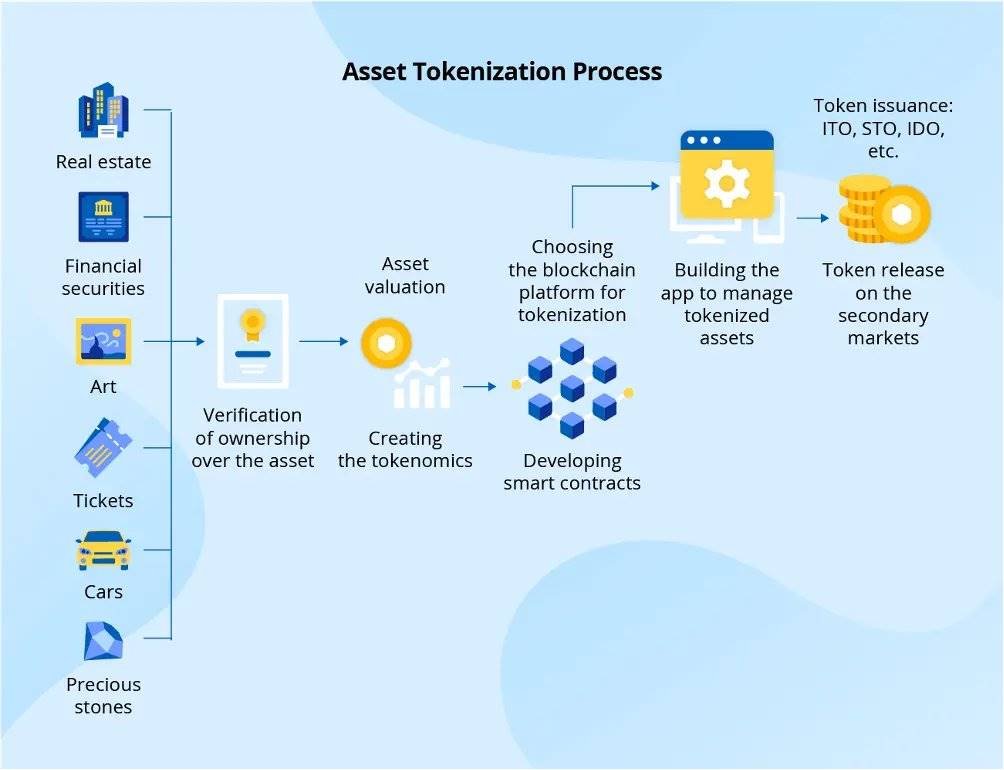
The four methods of tokenization are as follows:
Direct title: In this approach, the digital token itself acts as the official record of ownership, eliminating the need for a custodian. This approach is only applicable to digitally native assets. The system uses a single ledger (which may be a distributed ledger) to record token ownership. For example, instead of issuing a token backed by a share registry, the registry can be tokenized directly, making the token the actual record of ownership. This streamlined approach eliminates the need for a custodian or duplicate registries. While this approach can use a distributed ledger, the registry itself does not necessarily need to be distributed. However, the current legal framework for most asset classes for this tokenization approach is still limited and the regulatory structure is immature.
1:1 asset-backed tokens: In this approach, the custodian holds the asset and issues a token that represents a direct interest in that underlying asset. Each token can be redeemed for the actual asset or its cash equivalent. For example, a financial institution could issue a bond token based on bonds held in a trust account, or a commercial bank could issue a stablecoin token that is backed one-to-one by commercial bank currency in a dedicated account.
Collateralized tokens: This approach issues asset tokens collateralized by an asset other than the asset or underlying interest that is intended to represent it. Typically, tokens are overcollateralized to account for fluctuations in the value of the collateralized asset relative to the value of the underlying asset of the token. For example, the stablecoin Tether is backed not only by cash but also by a range of other assets such as fixed income securities. Similarly, it is possible to create a government bond token backed by commercial bank bonds, or a stock token backed by an overcollateralized portfolio of underlying stocks.
Under-collateralized tokens: Tokens issued in this method are designed to track the value of an asset, but are not fully collateralized. Similar to fractional reserve banking, maintaining the value of the token requires active management of the fractional reserve portfolio and open market operations. This is a riskier form of asset tokenization and has historically failed. For example, the Terra/Luna stablecoin that collapsed was not backed by an independent asset, but relied on algorithmic stabilization through a supply control algorithm. Other less risky partially collateralized tokens have also been issued.
(III) Development history and current situation
1. Development History
Historically, physical certificates of possession have been used to prove ownership of assets. While useful, these certificates are vulnerable to theft, loss, forgery, and money laundering. Digital possession tools have emerged as a potential solution since the 1980s. Examples include: RSA digital signatures, blind signatures and electronic cash, digital certificates and public key infrastructure (PKI)
However, limited computing power and encryption technology at the time prevented this tool from being realized. Instead, the financial industry turned to centralized electronic registration systems to record digital assets. Although these paperless assets brought certain efficiency improvements, their centralized nature required the participation of multiple intermediaries, which introduced new costs and inefficiencies.
One of the earliest forms of RWAs is stablecoins. Stablecoins are tokenized versions of fiat currencies that provide a stable unit of exchange. Since 2014, companies such as Tether and Circle have issued tokenized stable assets that are backed by real-world collateral such as bank deposits, short-term bills, and even physical gold.
In 2019, in addition to creating tokenized versions of fiat currencies, companies such as Paxos launched tokenized versions of gold, whose value is pegged to the price of a specific amount of money. Tokenized gold is backed by physical gold stored in bank vaults and verified through monthly attestation reports.
In 2021 and 2022, private credit markets emerged through unsecured lending platforms such as Maple, Goldfinch, and Clearpool, allowing established institutions to borrow funds based on their creditworthiness. However, these protocols were affected by the collapse of Luna, 3AC, and FTX, and experienced major defaults.
As DeFi yields plummeted in 2023, tokenized Treasuries exploded as users rushed in to gain exposure to rising U.S. Treasury rates. Providers such as Ondo Finance, Franklin Templeton, and OpenEden saw significant inflows as the total locked value of tokenized Treasuries surged 782% from $104 million in January 2023 to $917 million by the end of the year.
2. Development status
According to defillama data, the current TVL of the RWA track is approximately US$9 billion, a 34% increase from the beginning of 2024 (US$6.7 billion).

3. Main participants
As shown in the following table:
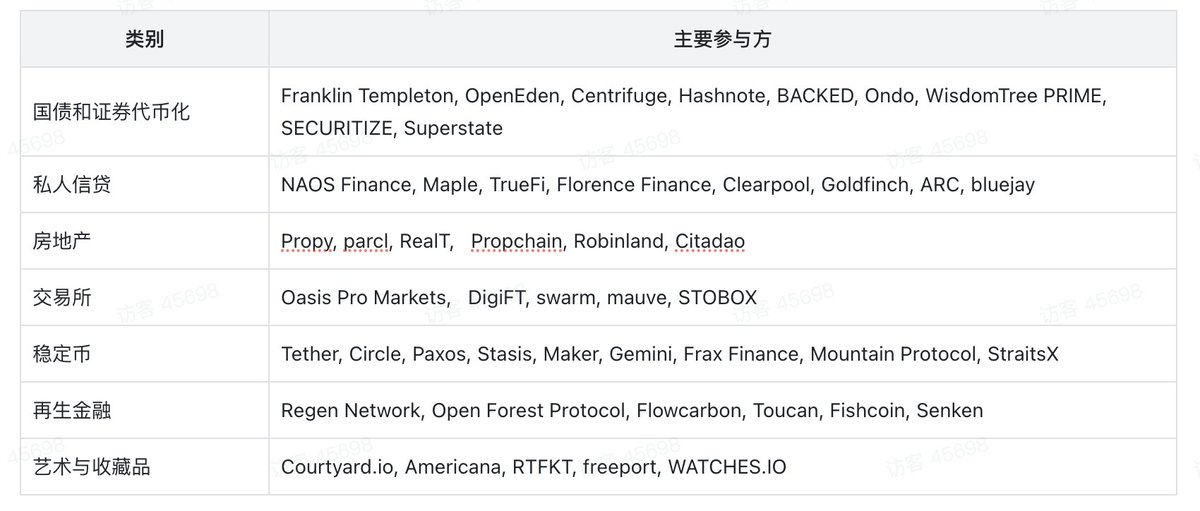
According to market data, as of February 24, 2025, the top 10 RWA track projects with the largest total locked volume are shown in the following table:
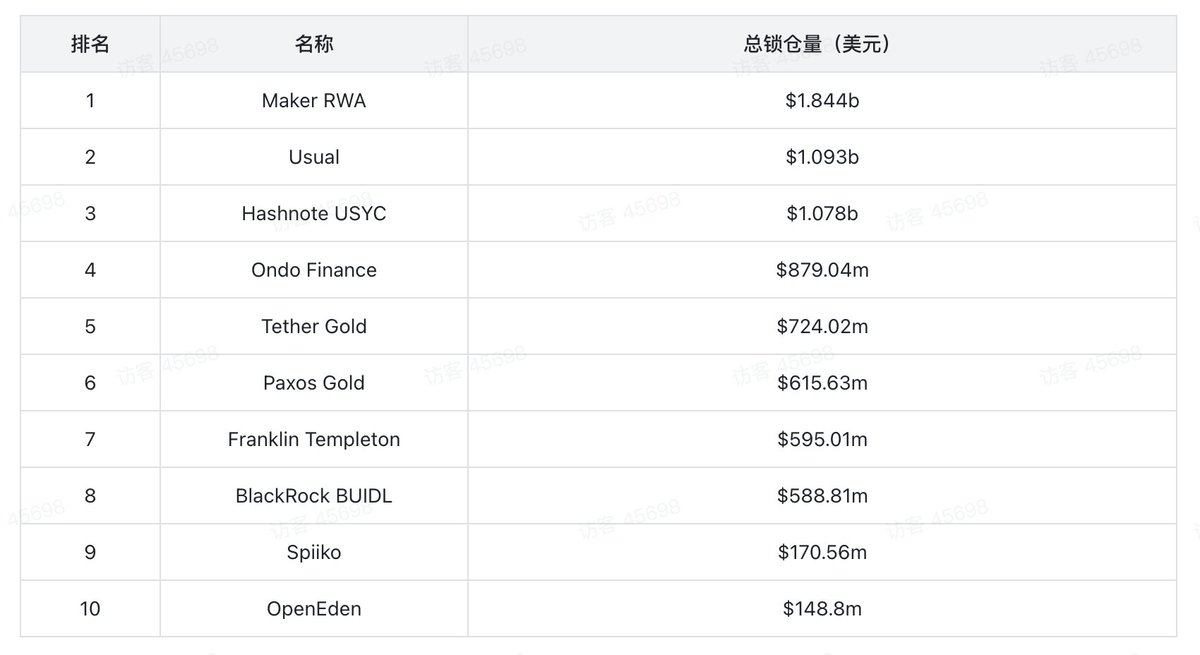
(IV) Track Advantages
1. Significance to web3
(1) Value support
In the overall macro context, DeFi assets lack yields; at the same time, the yields of DeFi assets fluctuate greatly and it is difficult to provide certainty; in comparison, traditional financial products are richer and more diverse, with more complete hedging methods, and can provide more stable returns. In addition, the valuation system is mature, and putting real assets on the chain will play a key role in supporting the value of the web3 industry;
For cryptocurrency assets with solid value support, the market will be more willing to provide liquidity for them, and investors' willingness to hold them will also increase, which can reduce the problems of insufficient liquidity and overall excessive concentration of non-head cryptocurrencies to a certain extent.
(2) Resisting cyclical fluctuations
Assets on the blockchain are highly correlated, and market fluctuations can easily trigger linkages among all types of assets, making lending agreements prone to runs or large-scale liquidations, further exacerbating market volatility. Introducing real-world assets, especially real estate, bonds and other assets that are more stable and have a lower correlation with the native cryptocurrency market, can achieve a certain degree of hedging, enrich the asset types and investment strategies of the DeFi system, and help the overall Web3.0 economic ecosystem become healthier.
(3) Diversification of on-chain asset management products
On-chain asset management seeks stable returns and good liquidity, and financial products such as U.S. Treasury bonds are widely recognized investment targets.
(4) Building a bridge of transformation and trust
Bringing real-world assets onto the chain is a bridge for the transformation of traditional finance to decentralized finance, and also a bridge of trust.
2. Significance to the traditional financial sector
(1) Improved investment flexibility
Tokenization democratizes investment opportunities by fragmenting high-value assets, such as real estate and art, into tradable tokens, enabling fractional ownership and enabling small investors to participate in markets that were previously inaccessible due to high costs.
(2) Improving liquidity and price discovery capabilities
Tokenization can reduce friction in the process of asset sales, transfers, and record keeping, allowing previously illiquid assets to be traded seamlessly at near-zero cost.
In traditional financial markets, the transfer of assets usually involves multiple intermediaries, which makes the transaction process complicated and time-consuming. Take rare gemstones or private equity as an example. In the past, it was very difficult for investors to trade positions in these asset classes, and they often had to spend a lot of time and effort to find buyers or sellers.
Tokenization simplifies this process by leveraging the decentralized nature of blockchain, allowing buyers and sellers to trade directly, thereby reducing transaction costs. With blockchain technology, investors no longer have to wait months or even years to find the right buyer, but can quickly transfer assets to other investors when needed, thereby providing secondary market liquidity in a safe and compliant manner.
In addition, buyers and sellers can conduct transactions more conveniently and price assets based on the latest relevant information. This transparency and real-time nature allows market participants to more accurately assess the value of assets and make more informed investment decisions.
(3) Improving the transparency of financial products and reducing systemic risks
The 2008 financial crisis is a classic example of a global financial disaster caused by financial derivatives. During this crisis, financial institutions packaged subprime loans into securities (such as mortgage-backed securities MBS and collateralized debt obligations CDOs) and sold them to investors, forming complex financial products that made it impossible to track the physical assets behind them.
Under the blockchain system, investors can easily and transparently trace the underlying assets of financial products, thereby reducing the possibility of systemic risks at the root.
(V) Potential risks
1. Risk of splitting ownership between the real world and the virtual world
Although real-world assets can be traded on-chain through tokenization, and some assets can also be traded through tokenization, the physical characteristics of some real-world assets make it impossible to actually transfer assets, so they are still subject to restrictions such as sovereignty at the physical level;
2. Risk of consistency between reality and crypto market
The trust and consistency between assets and on-chain data is the core challenge of RWA on-chain. The key to RWA on-chain is to ensure the consistency between assets in the real world and on-chain data. For example, after real estate is tokenized, the ownership, value and other information recorded on the chain must fully match the legal documents and asset status in reality.
However, this involves two key issues: one is the authenticity of the on-chain data, that is, how to ensure that the source of the on-chain data is credible; the other is data synchronization update, that is, how to ensure that the on-chain information can reflect the status changes of real assets in real time. Solving these problems usually requires the introduction of a trusted third party or authoritative organization (such as a government or certification agency), but this conflicts with the decentralized nature of the blockchain, and the trust issue remains an unavoidable core challenge for RWA on-chain.
3. Balance between decentralization and compliance
In terms of legal recognition, tokenized assets must have the same legal effect as real-world assets. This means that the ownership, liability, and protection of tokenized assets should be consistent with traditional legal frameworks. However, without proper regulatory coordination, the ownership of tokenized assets may face the risk of being difficult to enforce in court or not recognized in certain jurisdictions.
However, the above-mentioned conditions of regulatory and judicial supervision are contrary to the decentralized vision of blockchain itself. How to find a balance between compliance and decentralization in the RWA track remains a challenge.
Ondo Finance as a Use Case Analysis
1. Basic Information
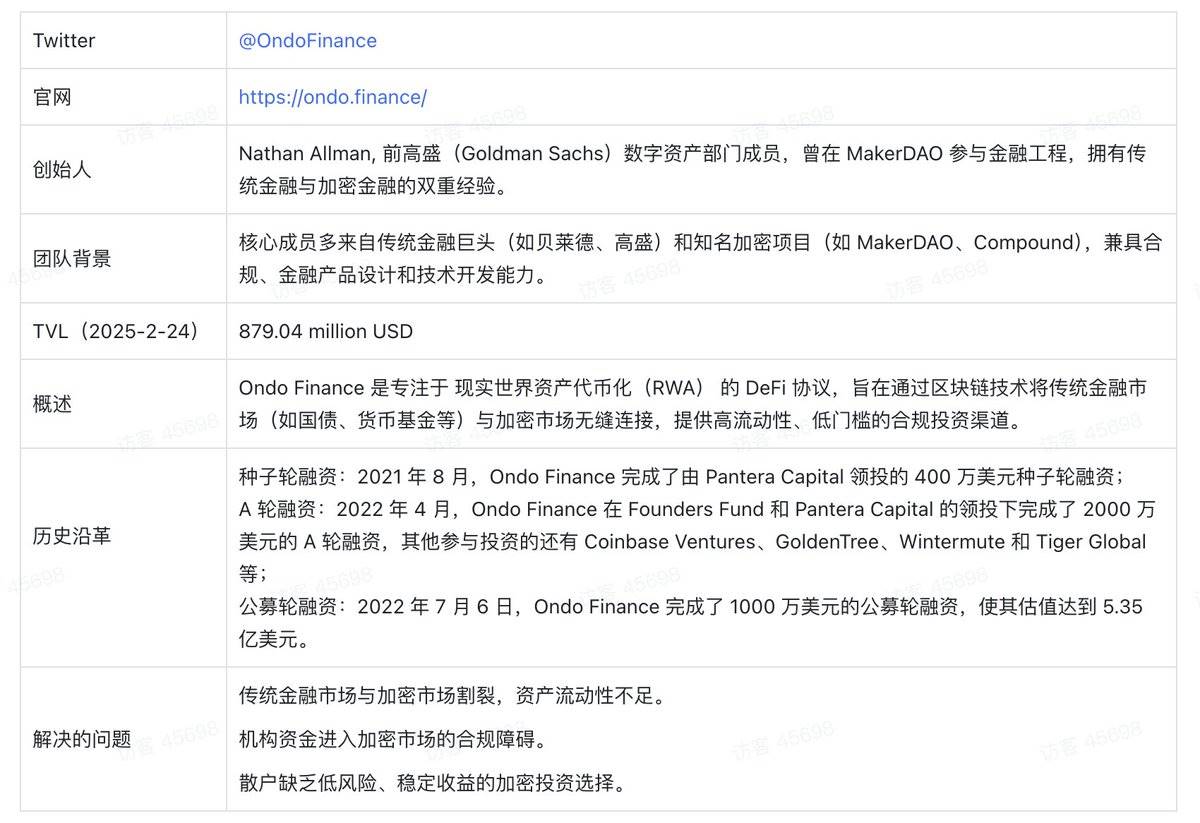
(II) Product status
1. Own products
(1) USDY (US dollar interest rate)
USDY is a tokenized note backed by short-term U.S. Treasury bonds and bank demand deposits. USDY is available to ordinary investors, with a purchase amount of more than $500, and can be minted and transferred on the chain 40-50 days after purchase.
Compared with the stablecoins USDT and USDC that are frequently used in the crypto world, USDY is more like an interest-bearing stablecoin, and can also be classified as an interest-bearing stablecoin. However, compared with other interest-bearing stablecoins, it is backed by traditional banks, and according to its official website, USDY complies with US regulatory requirements.
Since USDY can be minted and circulated on the chain after a certain period of time and operate as a stable currency, the structural design and risk control of USDY are particularly important. The following are the key points of USDY design and supervision methods.
Structural design: USDY is issued by Ondo USDY LLC and acts as an SPV. Assets are managed separately from Ondo Finance and independent books and accounts are maintained. This structure ensures the separation of USDY collateral assets from the potential financial risks of Ondo Finance;
Overcollateralization: USDY uses overcollateralization as a risk mitigation measure. The minimum 3% first loss position is used to mitigate short-term fluctuations in US Treasury prices. Currently, USDY is overcollateralized by 4.64% of the first loss position;
First priority: USDY investors have "first priority" on underlying bank deposits and treasury bonds. Ankura Trust acts as a collateral agent to oversee the security interests of USDY holders. A control agreement is established with the banks and custodians holding the assets, granting Ankura Trust the legal rights and obligations to control the assets and repay token holders in the event of a specific default or when the loan is accelerated through a vote by USDY holders;
Daily Transparency Reports: Ankura Trust acts as a verifier and provides daily transparency reports on reserves. These reports detail asset holdings, ensuring transparency and accountability. Reports are independently verified, providing additional assurance of reliability;
Asset Allocation: USDY adopts a cautious investment strategy to maintain the safety and liquidity of funds. The asset allocation target is 65% bank deposits and 35% short-term US Treasury bonds. This conservative investment approach focuses only on these safe and liquid instruments to minimize risk exposure;
Asset Custody: The US Treasury bonds that support USDY are stored in Morgan Stanley and StoneX's "cash custody" accounts to ensure asset safety. These assets will not be re-pledged again. Ankura Trust verifies the existence of these deposits every day.
Through the above methods, USDY products isolate assets and crypto projects to reduce project RUG risks; over-collateralize collateral to buffer the risk of a treasury bond interest rate cut; Ankura Trust acts as a regulatory agency to protect the security of investors' funds and returns; and deposit collateral in a traditional bank's cash custody account to ensure that the funds will not be reused.
The investment threshold of USDY is lower than that of other RWA products, and in addition to purchasing with USDC on the chain, you can also participate through wire transfer.
(2) OUSG (US Treasury Bonds)
The majority of OUSG's underlying assets come from BlackRock's short-term U.S. Treasury ETF: iShares Short Treasury Bond ETF (NASDAQ: SHV), with a small portion being USDC and USD as liquidity.
It is worth noting that Ondo I LP, as the fund manager, manages the SHV ETF shares of OUSG purchased by investors. As the SPV of OUSG, Ondo I LP is a US entity, which is conducive to investor risk isolation and helps users redeem shares in emergencies (such as project bankruptcy).
(3) OMMF (U.S. Government Money Market Fund)
OMMF is an RWA token based on the U.S. government money market fund (MMF), and the product has not yet been officially released.
2. Competitive product analysis
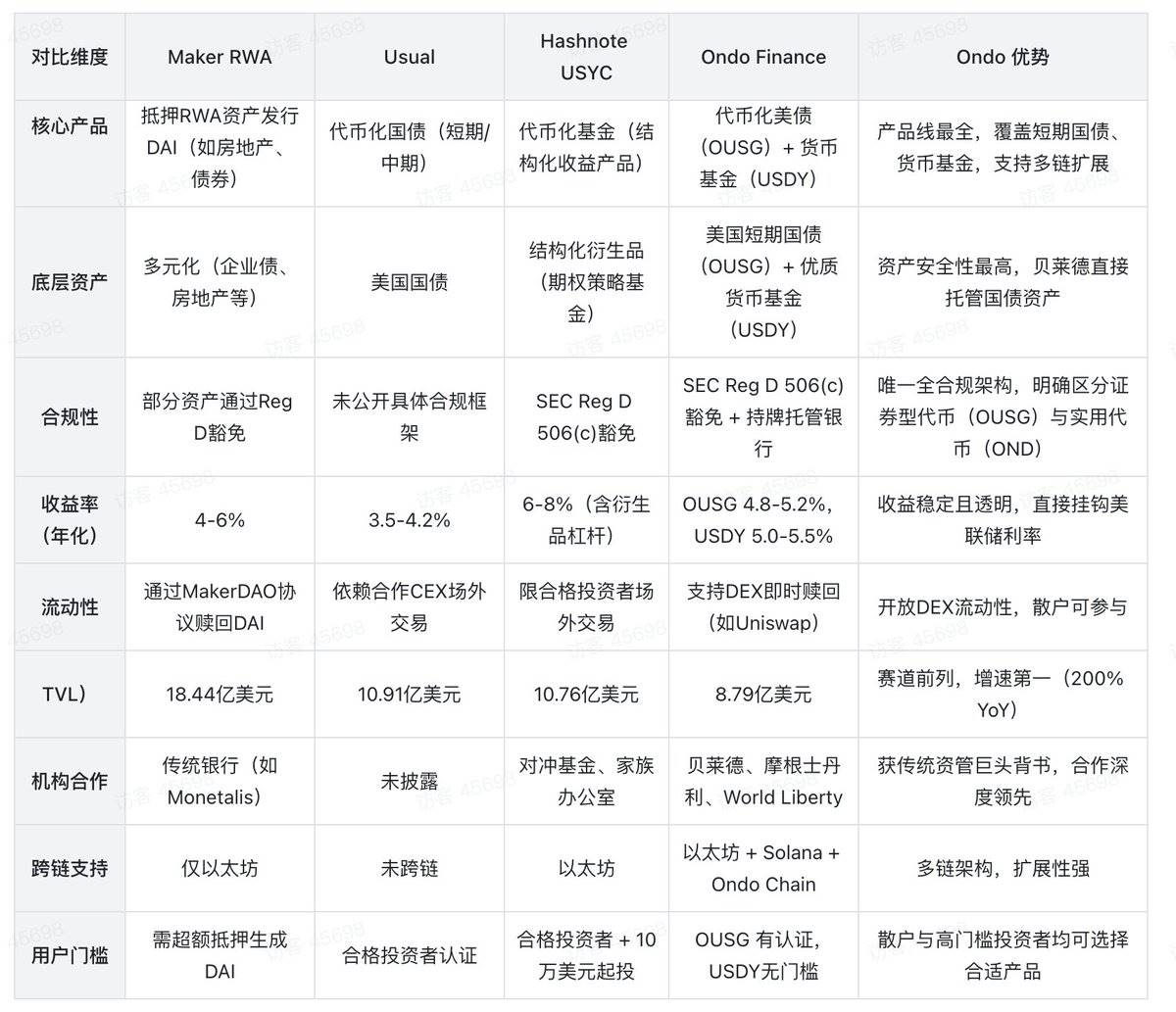
Token Economics
The ONDO token was launched on Ethereum in January 2024. It is the token that powers the Ondo Finance ecosystem. The maximum supply is 10 billion tokens, and the distribution is as follows:
Community Access Sale: 198,884,411 tokens (~2%) were distributed to early backers via CoinList, with ~90% unlocked at launch.
Ecosystem Growth: 5,210,869,545 tokens (~52.1%) for airdrops, contributor incentives, and expansion. 24% unlocked at launch, the rest vested over five years.
Protocol Development: 3,300,000,000 tokens (about 33%) are allocated to infrastructure and product construction, locked for at least 12 months and gradually unlocked over five years.
Private Sale: 1,290,246,044 tokens (approximately 12.9%) will be issued to Seed and Series A investors, with a lock-up period of at least 12 months and a gradual release over five years.
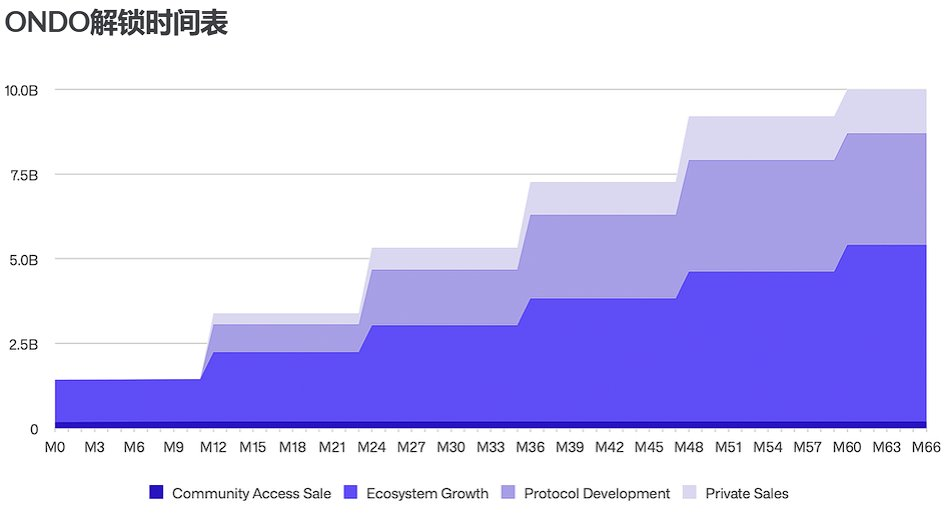
(IV) Compatibility between industry and track
1. In line with the industry's focus
The core narrative of the 2024-2025 bull market includes RWA, institutional entry and stable income demand, which is highly consistent with Ondo’s strategy;
2. Build a bridge between Tradfi and Defi
As a bridge for traditional financial institutions to deploy in web3, Ondo has installed a blockchain engine for traditional finance, allowing traditional financial assets to reshape liquidity on the chain, while providing solid value support for the cryptocurrency industry and meeting the two-way needs of Tradfi and Dfi.
3. Products meet industry needs
In the illiquid cryptocurrency market, Ondo chose U.S. Treasuries and related assets with high public recognition as the first step of RWA, which can provide liquidity while introducing RWA. At the same time, the cryptocurrency market is famous for its high returns and high volatility, which discourages many investors with low risk appetite. Ondo's stable RWA products undoubtedly increase the attractiveness of risk-averse investors to enter the cryptocurrency market.
4. Meet compliance and trust requirements
After a period of wild growth, the industry is bound to become standardized. Ondo has made its own attempt at the RWA solution that combines the openness of the public chain with institutional-level security. The attempt at compliance also means efforts to spread trust, which is in line with the future needs of the industry.
5. Innovation: Balancing Compliance and Decentralization
1. Native support for RWA assets
The core highlight of Ondo Chain is its native support for RWA assets, especially tokens issued by Ondo GM. Ondo Chain plans to support the staking of Ondo GM tokens and other high-quality liquid assets, which not only provides security for the network, but also creates income opportunities for idle assets.
2. Introduce cooperation with Tradfi institutions
By cooperating with traditional institutions such as Morgan Stanley, BlackRock, and Coinbase, which are also Ondo’s investors, we tokenize assets such as U.S. Treasury bonds and money market funds, strictly abide by relevant U.S. laws and regulations, and are more likely to gain the trust of investors;
Secondly, Ondo enables seamless connection with private networks and traditional financial environments by allowing a select group of financial institutions to run some verification nodes. This design can reduce transaction delays, prevent front-running transactions, and provide institutions with access to their unique assets and liquidity, further enhancing the attractiveness and practicality of Ondo Chain in institutional-level applications.
3. Accurate data on the chain to prevent fraud
Built-in oracles ensure real-time synchronization of data such as asset prices and interest rates, and the authenticity of the data is maintained by licensed verification nodes. This transparency reduces the possibility of market manipulation;
4. Cross-chain interoperability
Ondo Chain enables full-chain messaging and cross-chain asset transfers through native integration of Ondo Bridge. Its decentralized verification network (DVN) provides the main security guarantee for the system, and can be further enhanced with additional DVN when the transaction amount is high. More importantly, Ondo Chain supports seamless sharing of data such as KYC status, sanctions list, and collateral quantity, simplifying the process for developers to create full-chain applications.
5. A pioneer in compliance
(1) Securities Law Compliance: Reg D Exemption and Qualified Investor Restrictions
Reg D 506(c): Ondo’s tokenized U.S. debt products (such as OUSG and USDY) are issued in accordance with Reg D 506(c) of the U.S. Securities Act, which allows private placement of securities to accredited investors without SEC registration, but must meet the following requirements:
Investors need to verify assets (personal net worth > $1 million or annual income > $200,000)
The issuer needs to take reasonable steps to verify the investor's qualifications (such as bank statements, tax documents)
Tokens are prohibited from being publicly resold within one year after issuance
Compliance significance: Avoid being identified as an illegal public offering of securities and reduce the risk of SEC enforcement.
(2) Key Qualifications

(3) Compliance comparison with peers

6. Limitations
1. Over-reliance on institutions and lack of community drive
Ondo Finance's architecture relies heavily on the participation of traditional financial institutions, and the credibility and liquidity of tokenized assets are mainly supported by these institutions. While this guarantees asset quality and compliance, it also brings a core problem: its ecosystem is mainly oriented towards institutions, and the participation of retail users is limited. Compared with fully decentralized RWA projects, Ondo is more like an extension of the traditional financial world. The circulation and trading of tokenized assets mainly occur between institutions, reducing the influence of individual investors and decentralized communities.
2. Centralized power distribution under institutional control
Although Ondo Chain retains a certain degree of openness, its validators are permissioned, which means that core power is concentrated in the hands of a few institutions. This is in stark contrast to fully decentralized RWA projects, in which any participant can become a key node in the network. Ondo's design, to some extent, reflects the power structure of traditional finance, in which most of the control is still in the hands of a few large financial institutions. This centralized control may lead to conflicts in future governance and resource allocation, especially when the interests of token holders conflict with those of institutional players.
3. Compliance and legacy institutions may limit the speed of innovation
Since Ondo Finance's core pillars are compliance and institutional participation, this may limit its speed of innovation. Compared with fully decentralized projects, Ondo may face complex compliance processes and institutional approvals when launching new financial products or technologies. This may make it slower to respond in the rapidly developing crypto industry, especially when competing with more flexible DeFi projects, where compliance and institutional-oriented structures may become a burden.
(VII) Future Development
1. Products
Personally, I believe that Ondo Finance will continue to strengthen its cooperation with institutions in the future. Starting from the tokenization of liquid, high-yield and stable U.S. Treasury bonds, it will gradually use the product endorsements of the financial giants it cooperates with to introduce other financial assets of traditional financial companies onto the chain and increase its own market depth.
At the same time, Ondo can use the currently deployed U.S. Treasury RWA as a defensive base position in product development; develop real estate RWA to capture regional arbitrage (such as the rental yield difference between Southeast Asia and North America), carbon credit RWA as a hedging tool for black swan events (with a correlation of 0.72 with energy futures) and other RWA products, diversifying its own RWA product types to meet the diverse investment needs of investors.

Data source: MSCI RWA Index (2025Q2), backtest period 2023-2025
2. The essence of decentralization
How to maintain a balance between compliance and decentralization is still an open question for Ondo. In the context of the verification node licensing system, is the decentralized model just a facade? Can Ondo still meet its original vision as a member of the blockchain and meet the requirements of being tamper-proof and non-interferable?
(VIII) Investment advice
1. Short-term advice: investment
(1) Periodicity
Judging from the fluctuations of blockchain cycles, if the bear market comes in the future, mainstream stablecoin protocols such as Ondo and EVA may become the darlings of the market, and their US debt products are suitable for investors with lower risk appetite.
(2) The cooperation between Tradfi and Defi is still in the honeymoon period
At present, I think Tradfi and Defi are still in the honeymoon period of cooperation, and RWA is a win-win cooperation for both parties. Both parties will accelerate the incubation of more valuable RWA products during the honeymoon period, and Ondo's business will also usher in a rapid development cycle, which is a good time to intervene in investment.
(3) Rich driving factors (see Appendix 1)
According to the driving force factor model (4+3 factors), Ondo has strong driving force in Benchmark, Status, Vision, Useful, and Revenue Generation. However, its weak token economic model, single income and competitive pressure are the main risks. If Ondo Chain can successfully connect traditional finance with on-chain liquidity, its valuation is expected to exceed 10 billion US dollars.
(4) Undervaluation (see Appendix 2 for details)
According to the absolute valuation method, under the assumptions of WACC 22%, profit margin 30%, and perpetual growth of 8%, if the number of tokens remains unchanged, the price of each ONDO token is valued at $1.81. Currently, data on February 24 shows that the price of Ondo is $1.23, which has room for growth.
appendix
1. Valuation driving force analysis (4+3)
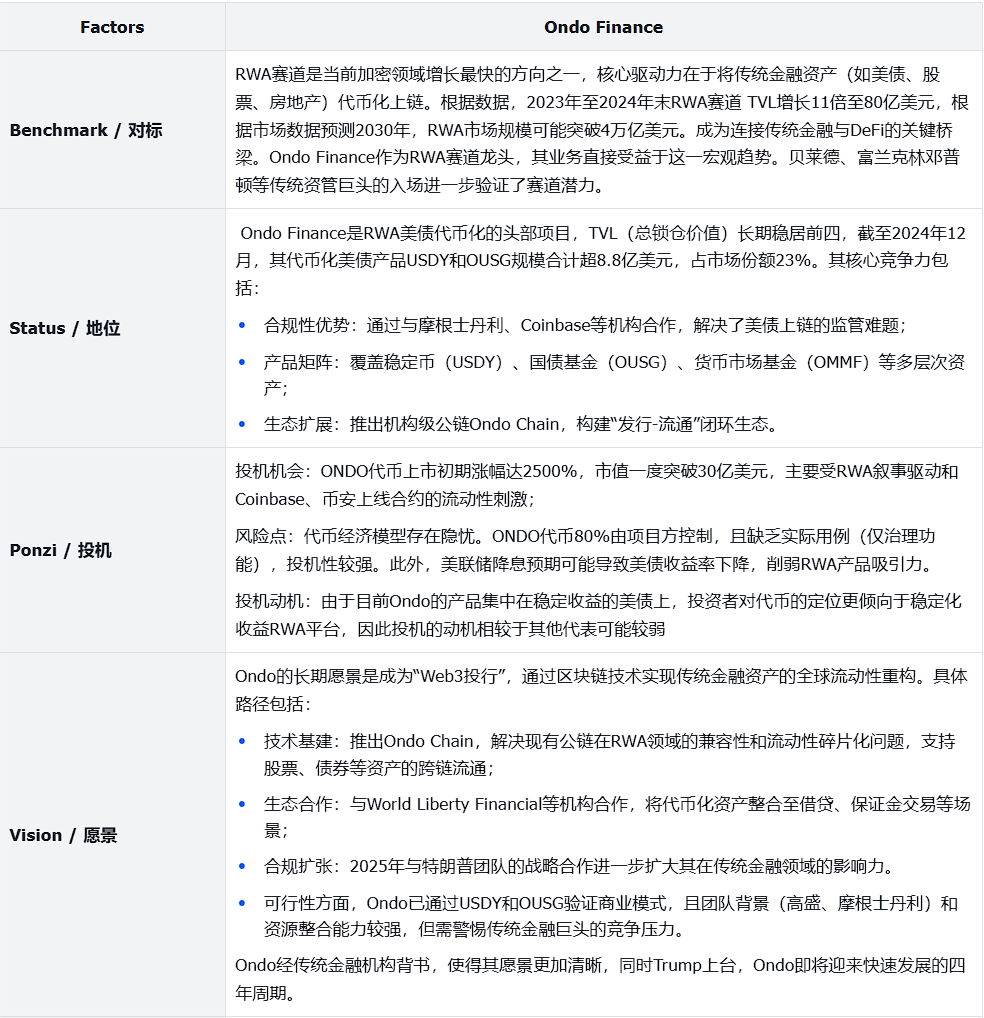
Ondo Finance has taken a leading position in the RWA track by virtue of its compliance first-mover advantage and product innovation, but its weak token economic model, single revenue and competitive pressure are major risks.
Short-term speculative opportunities and long-term value need to be judged in combination with the Fed’s policies and the progress of ecological expansion. If Ondo Chain can successfully connect traditional finance with on-chain liquidity, its valuation is expected to exceed 10 billion US dollars.
2. Ondo Finance (ONDO) Valuation Analysis on February 24, 2025 (Based on Hybrid Model)
1. TVL growth assumptions and cash flow forecasts
1. TVL growth path

2. Free Cash Flow (FCF) Calculation
Agreement fee rate: 1.00% (TVL × fee rate) (including: 0.35% asset management fee rate, 0.5% pledge fee rate, 0.15% transaction fee rate)
Cost ratio: 30% (Gas fee 15% + Audit 5% + Operation 10%)
Annualized FCF = TVL × 1.00% × 70%
2. Calculation of hybrid valuation model
1. Traditional DCF
(1) Discount rate and perpetual value
Discount rate: 22% (WACC 12% + Web3 risk premium 10%)
Perpetual Value (Gordon Model):

DCF value per token: 521.8 million / 1.445 billion ≈ 0.36 USD
2. Web3-specific factor modeling
(1) Token Economic Multiplier
Staking income: Staking ratio 30%, Staking amount = 1.445 billion × 30% = 433.5 million, annualized rate of return 8% Staking income present value = 4.335 × 8% × 1.23 (current price) / 22% (WACC) / 14.45 = 0.13 USD / token
Governance premium: Governance participation rate 15%, premium + 9% → $0.11/token
(2) Network Effect Value
Network effect value = β1⋅TVL^k = 0.15*186.62^1.1/14.45/2.7 = $1.21/token
β₁=0.15 (Benchmarking the top projects: refer to the ratio of TVL to market value of DeFi protocols such as Compound and Aave. Example: When Compound's TVL is $10 billion, its market value is about $2.5 billion → β1=25/100^1.2≈0.15)
TVL index (k=1.1)
Theoretical basis: Modified Metcalfe's Law.
Original formula: Network value ∝ n2 (n is the number of users)
Reality Adjustment: Due to differences in asset liquidity, the network effect of TVL is weaker than direct user interaction and is reduced to 1.1.
Empirical support: Research shows that the value of DeFi protocols is correlated to 1.1-1.3 times the TVL (IEEE Blockchain Transactions, 2023). Ondo chose k=1.1 to balance conservatism and growth expectations.
(III) Comprehensive valuation results
Vtotal = 0.36 (DCF) + 0.13 (staking) + 0.11 (governance) + 1.21 (network) = 1.81 USD/token
4. Conclusion and operational recommendations
Reasonable valuation range: US$1.81-2.40
The current price is significantly undervalued, core driving factor: TVL growth engine.
Optimized agreement rates, 1% rate balances income and competitiveness
The cross-chain ecosystem exploded, and multi-chain assets were injected after Ondo Chain went online
However, according to the current market situation, the rise and fall of this asset may not be the best choice in the market. It is only analyzed as a research case in this research report.








